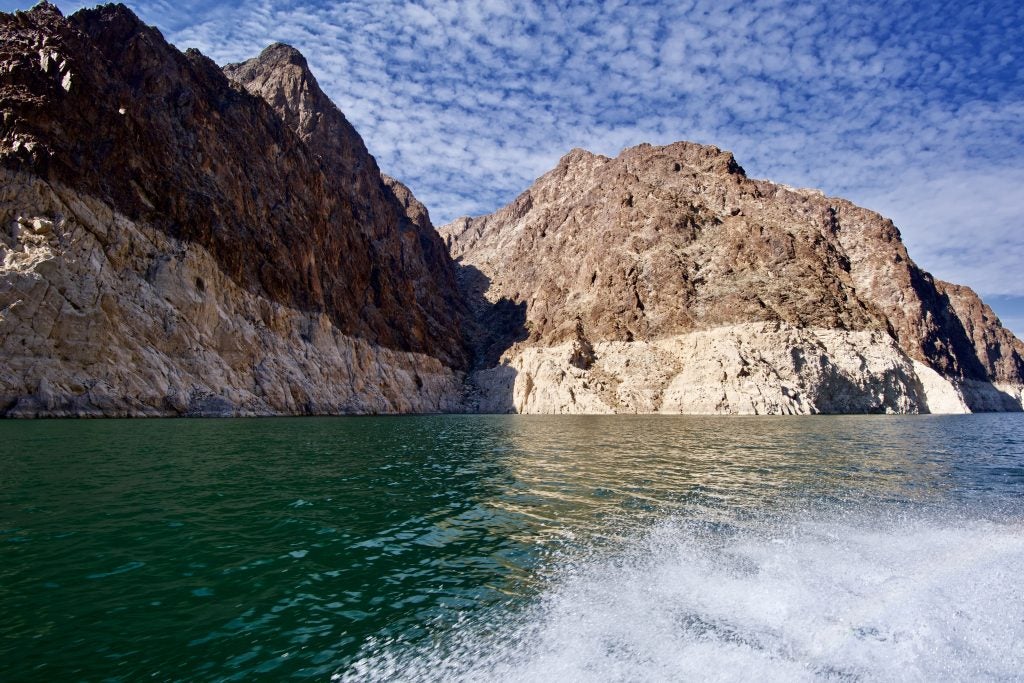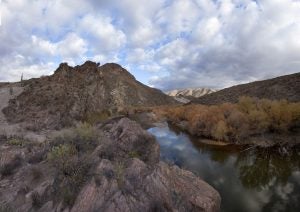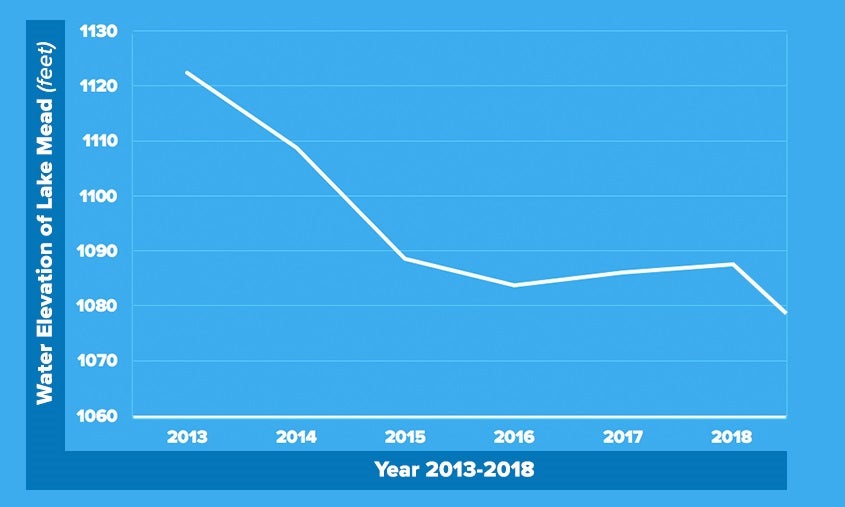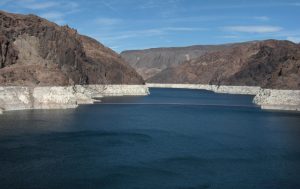A new website from EDF, American Rivers, and Four Corners Mapping provides a special look at the Grand Canyon through an educational, interactive journey. The interactive tool invites people to take a tour through the Grand Canyon and learn how the complexities of the Colorado River crisis impact the Grand Canyon and its surrounding communities and ecosystems through words, images, and short videos. Read More
Growing Returns
Selected tag(s): Lake Mead
EDF and partners launch interactive Grand Canyon website
New Lake Mead forecast spares Arizona – for now. Here are four critical steps to water security.
Arizona just got another temporary reprieve from water cuts in Lake Mead, for the second year in a row. However, sustainable water management — of both the Colorado River and groundwater — remains crucial for communities in the Southwest to become resilient to increasingly arid conditions.
A new, closely watched 24-month study of water levels on Lake Mead, the country’s largest reservoir, means Arizona has managed to avoid substantial water cuts next year. On Thursday, the U.S. Bureau of Reclamation predicted Lake Mead’s elevation will be 1,089.4 feet on Jan. 1, thanks to an unusually wet winter and seven states reaching a historic agreement on how to conserve Colorado River water. Read More
Three building blocks to water resilience for the Colorado River and beyond
One of the nation’s most important water agreements in recent history – the Colorado River Drought Contingency Plan – just crossed its last major milestone: winning bipartisan approval in Congress.
The driving force behind the water conservation plan is a nearly two-decade drought that has caused Lake Mead, a reservoir outside of Las Vegas, to fall to its lowest level ever. The drought plan outlines how Arizona, California and Nevada – the three states that rely on Lake Mead – will share cuts to avoid a crisis. The Upper Basin states of New Mexico, Colorado, Wyoming and Utah also agreed to operate reservoirs differently and begin exploring demand management to bolster Lake Powell.

Under the Colorado River Drought Contingency Plan, Arizona will need to reduce its share of Lake Mead water by 512,000 acre feet and Nevada will have to reduce its share by 21,000 acre feet when the lake’s elevation falls to 1,075 feet. California will have to reduce its share by 200,000 acre feet when the lake’s elevation falls to 1,045 feet. (Photo Credit).
The president’s signature is the final step of a multiyear, seven-state effort. But the Colorado River plan also marks a new beginning: the start of a highly productive period for water policy to build greater resilience to climate change across the country.
While recently attending the 10 Across Water Summit, I was struck by three common building blocks of successful water policy that apply across the Interstate 10 corridor and the nation: bottom-up visioning, collaboration and bridging the urban-rural divide. Read More
Drought Contingency Plan: Averting a looming crisis on the Colorado River
It’s finally time to celebrate that federal and state agencies as well as local water districts have agreed on the terms of Drought Contingency Plan (DCP) agreements in both the Upper and Lower Colorado River basins to manage water more sustainably.
The DCP is intended to incentivize water conservation while protecting existing water rights, recognizing the values of the basin’s agricultural communities and respecting the need to protect the basin’s environmental resources.
Representatives from the seven Colorado River Basin states gathered in Phoenix today to mark the historic milestone and publish a joint letter to Congress. In the letter, the states urge Congress to pass federal legislation by April 22 to authorize the Department of Interior to implement the DCP to address “a looming crisis.” Environmental Defense Fund signed a letter with our conservation partners expressing strong support for the DCP and urging Congress to support its enabling legislation. Read More
Critically low Lake Mead levels highlight need for Arizona action
Lake Mead water users this week learned we once again narrowly avoided water cutbacks by the skin of our teeth.
A 24-month projection released Wednesday by the U.S. Bureau of Reclamation shows we skirted federal mandatory water cuts for now, but prospects for 2020 do not look good. The forecast found Lake Mead water levels will end this month at 1,079 feet – a mere four feet away from the 1,075-feet threshold that would trigger a federal shortage declaration and mandatory cuts.
The report predicted Lake Mead will dip just below the threshold to 1,075 feet as early as May 2019 – in nine months. At the beginning of 2020, Lake Mead levels are predicted to be at approximately 1,070 feet and then predicted to fall to as low as 1,053 feet in the summer of 2020.
An official shortage declaration has been staved off until at least August 2019. That’s when the next key projection comes out, for January 1, 2020.
4 reasons why Arizona water is on the right track
Drought is the new normal in Arizona and the Colorado River Basin. The Colorado River is over-allocated, and potential reductions in Arizona water deliveries have become more and more likely.
Just last summer, we watched Lake Mead drop to one of its lowest levels ever. And even with a wet winter this year, Lake Mead’s elevation remains low. The river that provides 40 percent of Arizona’s water supplies needs our help.
A new deal
This summer, several parties came together to sign a “system conservation” agreement to address the situation. The State of Arizona, City of Phoenix, U.S. Bureau of Reclamation, and the Walton Family Foundation agreed to compensate the Gila River Indian Community to leave 40,000 acre feet of its 2017 Colorado River water entitlement in Lake Mead.
This is about 1.3 billion gallons of water, which is roughly the amount needed to serve 100,000 people in a year. The conserved water is designated as “system water” to help keep Lake Mead from falling below 1,075 feet – the elevation at which a federal shortage declaration is triggered and water delivery reductions are mandated (as stated in the proposed Lower Basin Drought Contingency Plan between Arizona, California, Nevada and the U.S. Bureau of Reclamation).
Inclusion and collaboration: Governor Ducey has a new strategy for water in Arizona
 Last week, Arizona Governor Doug Ducey illustrated strong and consistent leadership in addressing Arizona’s pressing water supply needs with two significant announcements.
Last week, Arizona Governor Doug Ducey illustrated strong and consistent leadership in addressing Arizona’s pressing water supply needs with two significant announcements.
A powerful voice for water
First, Governor Ducey appointed longtime water attorney and Gila River Indian Community member Rodney Lewis to the Central Arizona Water Conservation District (CAWCD) Board of Directors. This appointment was widely applauded across the region as a positive step, most notably as a sign that including diverse voices in water management decisions is key in moving the state toward improved sustainability and collaboration, both within Arizona and with regional partners in the Lower Colorado River Basin. Read More











